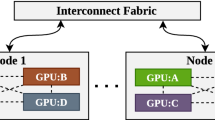Abstract
Recent studies have revealed that Convolutional Neural Networks requiring vastly many sum-of-product operations with relatively small numbers of parameters tend to exhibit great model performances. Asynchronous Stochastic Gradient Descent provides a possibility of large-scale distributed computation for training such networks. However, asynchrony introduces stale gradients, which are considered to have negative effects on training speed. In this work, we propose a method to predict future parameters during the training to mitigate the drawback of staleness. We show that the proposed method gives good parameter prediction accuracies that can improve speed of asynchronous training. The experimental results on ImageNet demonstrates that the proposed asynchronous training method, compared to a synchronous training method, reduces the training time to reach a certain model accuracy by a factor of 1.9 with 256 GPUs used in parallel.
Access this chapter
Tax calculation will be finalised at checkout
Purchases are for personal use only
Similar content being viewed by others
Notes
- 1.
Mutexes need to be implemented in appropriate places to avoid read/write collisions.
- 2.
See http://image-net.org for details.
- 3.
See https://www.cs.toronto.edu/~kriz/cifar.html for details.
- 4.
Each compute node of TSUBAME-KFC/DL contains 2 Intel Xeon E5-2620 v2 CPUs and 4 NVIDIA Tesla K80. Since K80 contains 2 GPUs internally, each node has 8 GPUs for total. FDR InfiniBand is equipped for interconnect.
- 5.
In every case the learning rate is varied from 0 to the target value linearly from the beginning of the training until the end of the first epoch for stability. After this period, the learning rate is held fixed at the target value.
References
He, K., Zhang, X., Ren, S., Sun, J.: Deep residual learning for image recognition. In: IEEE Conference on Computer Vision and Pattern Recognition, pp. 770–778 (2016)
Szegedy, C., Liu, W., Jia, Y., Sermanet, P., Reed, S., Anguelov, D., Erhan, D., Van- houcke, V., Rabinovich, A.: Going deeper with convolutions. In: IEEE Conference on Computer Vision and Pattern Recognition, pp. 1–9 (2015)
Lin, M., Chen, Q., Yan, S.: Network in network. In: International Conference on Learning Representations (2014)
Russakovsky, O., Deng, J., Su, H., Krause, J., Satheesh, S., Ma, S., Huang, Z., Karpathy, A., Khosla, A., Bernstein, M., Berg, A.C., Fei-Fei, L.: ImageNet large scale visual recognition challenge. Int. J. Comput. Vis. 115(3), 211–252 (2015)
Krizhevsky, A., Ilya, S., Hinton, G.E.: Imagenet classification with deep convolutional neural networks. In: Neural Information Processing Systems, pp. 1097–1105 (2012)
Dean, J., Corrado, G.S., Monga, R., Chen, K., Devin, M., Le, Q.V., Mao, M.Z., Ranzato, M., Senior, A., Tucker, P., Yang, K., Ng, A.Y.: Large scale distributed deep Networks. In: Neural Information Processing Systems, pp. 1223–1231 (2012)
Iandola, F.N., Ashraf, K., Moskewicz, M.W., Keutzer, K.: Firecaffe: near-linear acceleration of deep neural network training on compute clusters arXiv:1511.00175 (2015)
Zheng, S., Meng, Q., Wang, T., Chen, W., Yu, N., Ma, Z., Liu, T.: Asynchronous stochastic gradient descent with delay compensation for distributed deep learning arXiv:1609.08326 (2016)
Wu, R., Yan, S., Shan, Y., Dang, Q., Sun, G.: Deep Image: Scaling up image recognition arXiv:1501.02876 (2015)
Gupta, S., Zhang, W., Wang, F.: Model accuracy and runtime tradeoff in distributed deep learning: a systematic study. In: IEEE International Conference on Data Mining, pp. 171–180 (2016)
Zhang, W., Gupta, S., Lian, X., Liu, J.: Staleness-aware async-SGD for distributed deep learning. In: International Joint Conferences on Artificial Intelligence, pp. 2350–2356 (2016)
MPI: A message-passing interface standard. http://mpi-forum.org/docs/mpi-3.1/mpi31-report.pdf
Oyama, Y., Nomura, A., Sato, I., Nishimura, H., Tamatsu, Y., Matsuoka, S.: Predicting statistics of asynchronous SGD parameters for a large-scale distributed deep learning system on GPU supercomputers. In: IEEE Big Data, pp. 66–75 (2016)
Jaderberg, M., Czarnecki, W.M., Osindero, S., Vinyals, O., Graves, A., Kavukcuoglu, K.: Decoupled neural interfaces using synthetic gradients arXiv:1608.05343 (2016)
Nesterov, Y.: A method of solving a convex programming problem with convergence rate \(O (1/k^2)\). Sov. Math. Dokl. 27, 372–376 (1983)
Qian, N.: On the momentum term in gradient descent learning algorithms. Neural Netw. 12(1), 145–151 (1999)
Krizhevsky, A.: Learning multiple layers of features from tiny images. Master’s thesis, Computer Science Department, University of Toronto (2009)
Simard, P.Y., Steinkraus, D., Platt, J.C.: Best practices for convolutional neural networks applied to visual document analysis. In: IAPR International Conference on Document Analysis and Recognition, pp. 958–963 (2003)
Nair, V., Hinton, G.E.: Rectified linear units improve restricted Boltzmann machines. In: International Conference on Machine Learning, pp. 807–814 (2010)
Author information
Authors and Affiliations
Corresponding author
Editor information
Editors and Affiliations
Rights and permissions
Copyright information
© 2017 Springer International Publishing AG
About this paper
Cite this paper
Sato, I., Fujisaki, R., Oyama, Y., Nomura, A., Matsuoka, S. (2017). Asynchronous, Data-Parallel Deep Convolutional Neural Network Training with Linear Prediction Model for Parameter Transition. In: Liu, D., Xie, S., Li, Y., Zhao, D., El-Alfy, ES. (eds) Neural Information Processing. ICONIP 2017. Lecture Notes in Computer Science(), vol 10635. Springer, Cham. https://doi.org/10.1007/978-3-319-70096-0_32
Download citation
DOI: https://doi.org/10.1007/978-3-319-70096-0_32
Published:
Publisher Name: Springer, Cham
Print ISBN: 978-3-319-70095-3
Online ISBN: 978-3-319-70096-0
eBook Packages: Computer ScienceComputer Science (R0)




